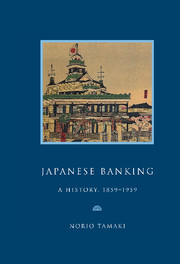Book contents
- Frontmatter
- Contents
- Preface
- Genealogy of leading Japanese banks, 1859–1959
- List of abbreviations
- Map
- Part I A bankrupt Shogunate, 1859–1868
- Part II The Meiji Restoration: monetary confusion and banking experiments, 1868–1881
- Historical background
- 5 The first banking experiment, 1868–1872
- 6 The national bank system: the American influence, 1870–1881
- 7 The origins of ordinary banking: another bank mania, 1875–1881
- 8 The search for stability: the last bank controversy, 1879–1881
- Part III Matsukata, the wizard of Japanese banking, 1881–1897; the Yokohama Specie Bank (1880) and the Bank of Japan (1882)
- Part IV The Japanese on the London money market, 1897–1911
- Part V War, the Japanese boom years, 1911–1919
- Part VI Crisis and the road to war, 1919–1937
- Part VII Complete commitment, struggle and defeat, 1937–1945
- Part VIII American ‘democratisation’ and the search for growth, 1945–1959
- An extraordinary century, 1859–1959
- Appendices
- Notes
- Bibliography
- Index
8 - The search for stability: the last bank controversy, 1879–1881
Published online by Cambridge University Press: 03 February 2010
- Frontmatter
- Contents
- Preface
- Genealogy of leading Japanese banks, 1859–1959
- List of abbreviations
- Map
- Part I A bankrupt Shogunate, 1859–1868
- Part II The Meiji Restoration: monetary confusion and banking experiments, 1868–1881
- Historical background
- 5 The first banking experiment, 1868–1872
- 6 The national bank system: the American influence, 1870–1881
- 7 The origins of ordinary banking: another bank mania, 1875–1881
- 8 The search for stability: the last bank controversy, 1879–1881
- Part III Matsukata, the wizard of Japanese banking, 1881–1897; the Yokohama Specie Bank (1880) and the Bank of Japan (1882)
- Part IV The Japanese on the London money market, 1897–1911
- Part V War, the Japanese boom years, 1911–1919
- Part VI Crisis and the road to war, 1919–1937
- Part VII Complete commitment, struggle and defeat, 1937–1945
- Part VIII American ‘democratisation’ and the search for growth, 1945–1959
- An extraordinary century, 1859–1959
- Appendices
- Notes
- Bibliography
- Index
Summary
Okuma's innovation: the Yokohama Specie Bank, or Shokin, 1879–1881
As more paper money was added to that already in circulation, serious depreciation continued. Depreciation against silver, the Japanese standard, which had been on average 3.3 per cent and 9.9 per cent in 1877 and 1878 respectively, reached 26.1 per cent in March 1879. Although the financial authorities were alarmed, their energies were otherwise occupied with political conflicts.
In 1878 in the wake of the assassination of Toshimichi Okubo, the most distinguished Meiji leader in the government, serious disagreement arose among the dajokan members and Shigenobu Okuma became a target. In order to disconcert his opponents, and allow himself a breathing space, Okuma resolved to make major recommendations. First he suggested that Japan should issue abroad national bonds for ¥50 million, or some £5 million, the proceeds of which would be used to redeem the paper money. This proposal was greeted by a storm of protest and Okuma conceded defeat in the spring of 1880. Horatio Nelson Lay's unscrupulous behaviour was indeed still vividly remembered by the oligarchs. Okuma, in a tight corner, had only one choice left. He suggested the establishment of a Specie Bank. Japanese merchants, centred around Yokohama, had also been lobbying for this. Okuma invited the merchants to set up a Specie Bank conjointly with the Finance Ministry and a prospectus was prepared. It was submitted to the chief minister of the dajokan in November 1879 and authorised without delay.
- Type
- Chapter
- Information
- Japanese BankingA History, 1859–1959, pp. 46 - 54Publisher: Cambridge University PressPrint publication year: 1995



